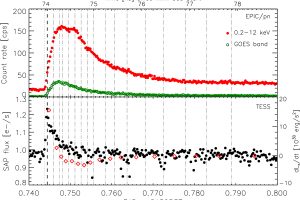A superflare observed in the M star AD Leo. The study: “The Great Flare of 2021 November 19 on AD Leo. Simultaneous XMM-Newton and TESS observations” of B. Stelzer (Eberhard-Karls-Universität Tübingen) appeared on A&A

Flares are transient and energetic phenomena that occur in most stars and can be observed with high spatial and temporal resolution in the Sun. These phenomena are triggered by a sudden release of energy previously stored in the star’s magnetic field, which, after a sequence of events, leads to extreme heating of the stellar plasma. The heated plasma then rapidly expands and is confined in the coronal magnetic field, typically in loop-like structures called “coronal loops,” which are filled with plasma at temperatures of millions of degrees. Since flares involve plasma with a wide range of densities and temperatures in the photosphere, chromosphere, and corona, they are associated with emissions in several bands of the electromagnetic spectrum, including optical and X-rays.
The most energetic event ever observed in the Sun is the Carrington event, which occurred in September 1859 and is estimated to have released a total energy of 4×1032 ergs. It was a peculiar event that even had consequences on Earth, such as disrupting telegraph lines. Typically, solar flares are orders of magnitude less energetic, releasing on average an energy of 1027 ergs per second.
In stars that are more active than the Sun (usually related to the star’s youth and/or rapid rotation), more energetic flares than the Carrington event have been observed, called “superflares.” These phenomena are interesting because they provide information on stars with extreme magnetic fields and since they can significantly affect the atmospheres of planets orbiting around these stars. The team led by astronomer B. Stelzer from Eberhard-Karls-Universität Tübingen (previously affiliated with INAF – Astronomical Observatory of Palermo) analyzed optical and X-ray observations of a superflare that occurred in the M star AD Leo. Optical observations were obtained from the NASA satellite TESS, while X-ray observations were obtained from the ESA satellite XMM-Newton. Due to the intensity of this flare and the proximity of AD Leo to us (only about 16.4 light-years away from the Sun), the authors were able to analyze this flare in detail, measuring a total released energy of 5.6×1033 erg, 14 times more energetic than the Carrington event. The coronal loop produced during the flare extended for about 4×109 cm, and the plasma reached a peak temperature of 37 million degrees. The authors concluded that, despite the large amount of energy released, this flare is a scaled-up version of the flares observed on the Sun, and not a new class of phenomena. The study is described in the paper “The Great Flare of 2021 November 19 on AD Leo: Simultaneous XMM-Newton and TESS Observations” recently published in the journal Astronomy & Astrophysics. Coauthors include C. Argiroffi (University of Palermo and INAF – Astronomical Observatory of Palermo) and M. Caramazza (Eberhard-Karls-Universität Tübingen, previously affiliated with INAF – Astronomical Observatory of Palermo).
The figure (click here to visualize the entire image) shows the light curve (the temporal variation of the observed flux in a given band) in the optical band and X-rays of the superflare in AD Leo. The top panel shows the X-ray light curve in the 0.2-12 keV band observed by XMM/Newton and the reconstructed light curve in the GOES 1.5-12.4 keV energy band (GOES is a satellite for solar observations). The bottom panel shows the optical light curve in the TESS band. The diamonds mark the time derivative of the X-ray variability. The comparison between the variability in optical and the X-ray time derivative probes the connection between the processes emitting in these bands. The thick vertical line marks the peak of the optical flare.
Mario Giuseppe Guarcello ( follow mariospiegacose) ( mariospiegacose) ( follow mariospiegacose)
Follow the Astronomical Observatory of Palermo on Facebok
Subscribe the Youtube channel of the Astronomical Observatory of Palermo
